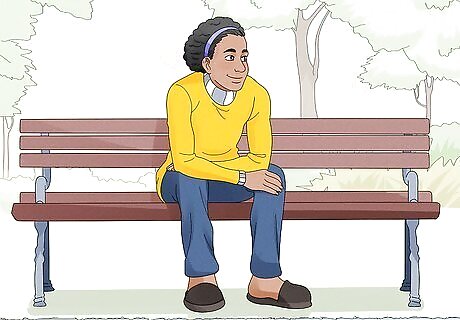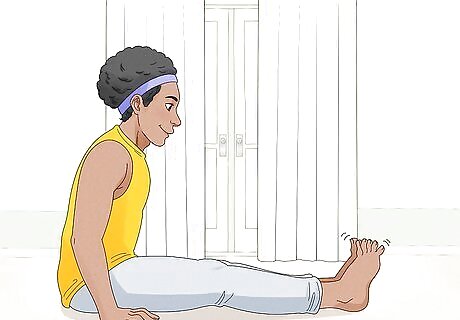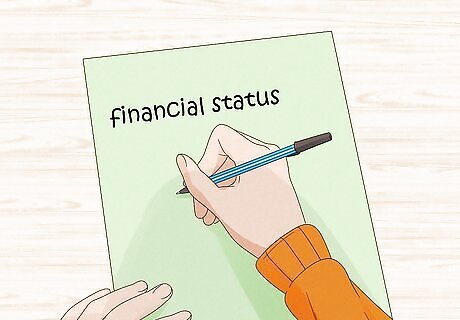
views
Distractions

Hang out with your friends. If you’re having trouble getting out of your head, sometimes the best answer is to be around other people. Hit up a friend, go hang out with your family, or have a chat with someone on the phone. Talking to other people can make you forget what you were in your head about in the first place. You can tell your friends that you’re struggling with your thoughts if you want to, but you don’t have to. When you hang out with your friends, really focus on what they’re saying and how they’re saying it. This can help you snap out of your spinning thoughts much faster. If you can’t hang out with someone in person or that seems like too much right now, try FaceTiming or video chatting instead.

Do some exercise. Going for a run, doing yoga, or lifting weights can all help you get out of your head. Since you’re focusing on your body, you won’t be able to ruminate on negative thoughts as much. Pick an exercise that you enjoy doing and get your blood pumping. Sticking with an exercise routine can improve your mental health overall, so it’s great practice in general. Swimming, jogging, playing basketball, riding a bike, or jumping rope are all great options too, and even just taking a walk can help you change your environment and get your body moving.

Enjoy a relaxing activity that you love. Dive into your favorite hobby, pick up a good book, or start a journal entry. Try to choose something that really focuses your mind so you can use it to distract your thoughts and focus on something else. If you’re having trouble picking up a new activity, stick with one you know you love and enjoy. Jigsaw puzzles, crossword puzzles, and word searches are all fun activities that focus your mind without much effort. Watching TV and scrolling through social media might be fun, but it isn’t very engaging for your mind. Try to choose something that focuses your brain power.

Pamper yourself. When’s the last time you took a bubble bath? Or painted your nails? Set aside 10 to 30 minutes to soak in the tub, do a face mask, or try a new body scrub. It’s a way to keep your mind engaged and relax your body at the same time. Negative thoughts can turn themselves into actual muscle aches, so soothing your body can make you feel better overall. If you have the time, book a massage!

Get organized. If you’re feeling stressed about school, work, money, relationships, or responsibilities, you can put some of that energy toward getting yourself organized. Try rounding up your textbooks, gathering important papers, or starting a to-do list. You don’t have to completely revamp your entire living or work space, but getting organized can help calm you down and give you a nice distraction. If you’re worried about money, try creating a budget for yourself. If you’re worried about relationships in your life, reach out to your friends, family, or partner. You might not be able to organize your entire life right now, and that’s totally fine. Focus on doing one small thing to work toward organization, then go from there. This is a great way to put your anxious energy into doing something concrete and helpful.
Grounding Exercises

Go somewhere peaceful. This doesn’t have to be a scenic meadow with chirping birds; your peaceful place can be your bedroom, your office, or the park outside your home. Wherever it is, try to go somewhere you feel like you can relax and destress. If you can’t leave your home and go somewhere else right now, that’s okay too. You can create a peaceful environment by wearing headphones or closing your eyes.

Focus on your breathing. This can help slow down your thoughts and divert your mind elsewhere. If it helps, you can close your eyes as you take a deep breath in, then another deep breath out. Try feeling the breath as it enters your nose, goes down into your lungs, then exits again. This is also a great way to reduce any anxiety you might be feeling. It can be tough to do this exercise at first, but when you practice it, it will help you relax and destress. Focusing on your breathing, a natural process that everyone does, is a good way to ground yourself and bring your thoughts back around to the present.

Use the 5-4-3-2-1 method to notice your surroundings. If you catch yourself spinning tons of thoughts in your head, you can pick out things around you with your various senses to bring you back into your body. First, pick out 5 things that you can see around you. Then, 4 things you can touch around you. Acknowledge 3 things that you can hear in your general area, 2 things you can smell, and 1 thing you can taste. This exercise can help you snap out of anxious or worrying thoughts and bring you back into your body as it exists now. You can do this exercise anywhere—at home, at school, during work, at the gym, or when you’re out running errands.

Splash some cool water on your face. Really think about how the water feels on your skin and your hair. When you dry your face off, think about the softness of the towel and how it feels against your body. Try to take a few minutes to do this so you can use it to center yourself. If you don’t want to get your face all wet, try taking a sip of cool water instead and noticing how it feels going in your mouth and down your throat.

Picture positive images in your mind. If you have a favorite place in nature that you like to go, try visiting that spot in your head. If you have a calming memory with friends or family members, revisit that one. Focusing on things that make you happy can calm you down and redirect your mental energy. If you’re having trouble focusing on positive images, look up some guided meditation videos on YouTube. Videos like this can tell you what to think about and keep you focused on your images.

Tense and release your muscles. Start with your toes, then move up to your legs, then your torso, your arms, and your face. Squeeze and hold each muscle group for 10 seconds, then release them. When you’re done, your body should feel more relaxed, and you may feel more grounded and connected with your body. As your body relaxes, your mind will, too. You might feel more comfortable doing this exercise in private, so excuse yourself to the restroom or your room while you do this one.
Tips for Handling Anxiety

Write down your worries. Get out a piece of paper and keep it with you throughout the day. If you catch yourself thinking something negative or anxiety-inducing, write it down. At the end of the day, you can look at your piece of paper and notice any patterns that come up in your mind. For example, if you write down a lot of worries about money, you’re probably anxious about your financial situation. Or, if you have a lot of worries about your career prospects, you might be concerned about your future.

Accept your thoughts without judgment. Even if your thoughts aren’t helpful, it doesn’t do any good to beat yourself up about them. Instead of getting angry at yourself, try observing your negative thoughts and analyzing them judgment-free. It can help you better understand why you’re thinking them and how you might stop them in the future. For example, if you’re thinking something like, “I’ll never graduate and get my degree,” you can accept the thought and analyze that you’re probably stressed about your upcoming exams. Or, if you’re thinking something like, “I’m not good enough to be an artist,” you can look at your thought and realize that you’re probably worried about your artistic abilities and how they measure up to other people’s.

Challenge the thoughts that give you anxiety. Often, when you’re in your head, you might be thinking thoughts that are irrational or have no evidence to support them. If you notice that you’re having thoughts like this, try asking yourself, “What’s the evidence that thought is true?” or, “Is this thought helpful right now?” Chances are, you won’t be able to find any evidence that your anxious thoughts are actually real. This can help you snap out of the cycle of repeating negative thoughts. You can also ask yourself, “Is my worry solvable?” If it is, great! Take steps toward solving your problem so you can move on. If it isn’t, chances are you don’t need to be worrying about it.

Repeat a positive mantra to yourself. If you’re stuck in a negative thought pattern, you can challenge those thoughts with a positive one. This mantra can be anything you’d like, but it should uplift you and ground you in some way. Some examples of positive mantras are: "I am worthy, and I am safe." "I am here in the present, not in the past or the future." "I can only control my own actions, not anyone else’s."

Focus on the present. Pay attention to how you feel here and now, not how you might feel tomorrow or in a year. Do some deep breathing, focus on your heart beat, and bring yourself back into the present to quiet down those negative thoughts in your head. This is also called “practicing mindfulness.” It can help you in a lot of situations, including when you’re feeling anxious.


















Comments
0 comment